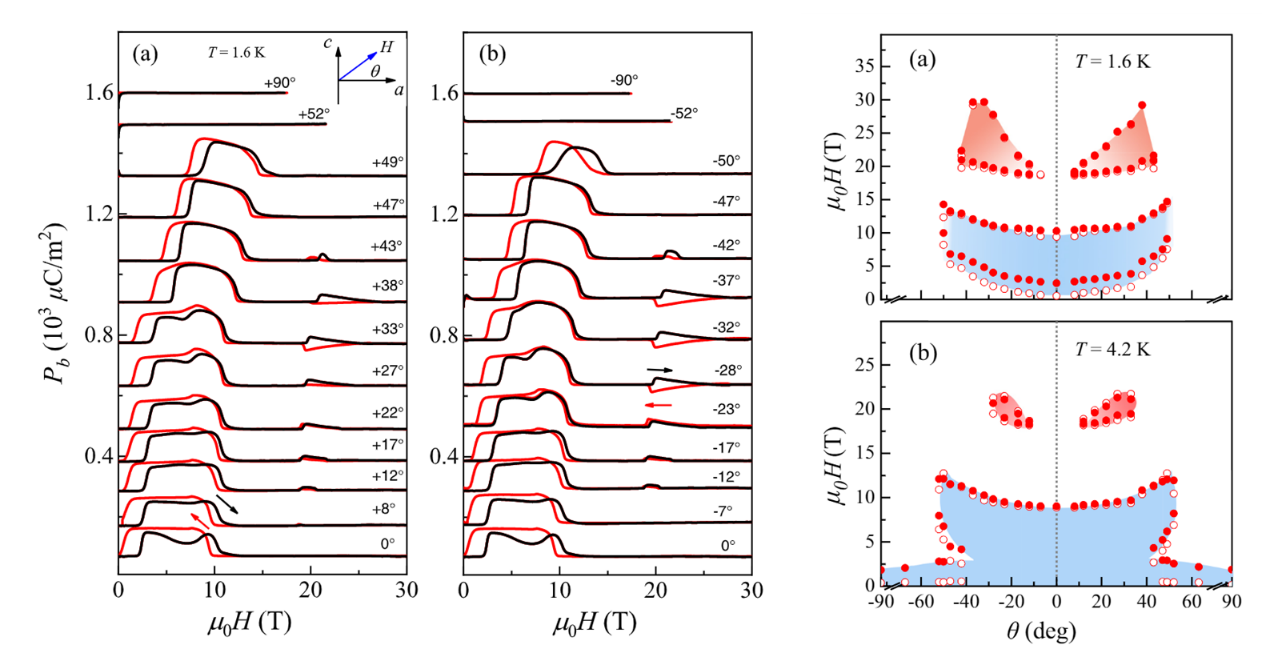
(a-b) The angular dependence of Pb within the ac-plane at 1.6 and 4.2K, respectively. (c-d) The H-θ phase diagrams at low temperatures.
Background
The essential geometric spin frustration in the kagome lattice has attracted tremendous research interest during the past decades, leading to exotic properties and candidature of the quantum spin liquid states. Along with the inversion symmetry breaking induced by the geometric distortion, ferroelectric order has been realized in buckled kagome staircase lattice compounds. The frustration of spins in the kagome staircase plays a central role by introducing noncollinear spin texture and thus multiferroics. The M3V2O8 family-with M being the divalent cation, varying among Mn, Ni, Co, and Cu-is a representative kagome staircase structure. Among the MVO family, Ni3V2O8 (NVO) has become a canonical example of a multiferroic system which has drawn considerable interest due to its rich magnetic phase diagram, provided the magnetic and ferroelectric orders are strongly coupled. Comparable interlayer interaction with intralayer interaction, as well as a high interlayer lattice constant, both reduce spin frustration through interlayer exchange coupling.
What we discover?
In the present work, we report a comprehensive angular dependent ferroelectric polarization study on Ni3V2O8 with the field rotating within the ac plane at low temperatures. The low field induced ferroelectric (LF) state along the crystallographic b axis, which has been observed when the field is applied parallel to the easy axis (a axis), is revealed to vanish suddenly as the field is rotating close to the c axis. Of particular interest is the observation of the reentrant ferroelectric (HF) phase at high field for various orientations when the field is between the a and c axes within a small angle range. The field-angle phase diagrams are built based on the low-temperature angular dependent polarization results and composed of a continuous LF phase and a discontinuous HF phase both exhibiting symmetry with respect to theaaxis. The microscopic origins of the two phases are different due to the two decoupled sublattices in the kagome staircase structure, where the low-field polarization is proposed to originate from the spiral structure of the spine spins, while the high-field phase is ascribed to the ordering of the cross-ties under a tilting high magnetic field.
Why is this important?
The present paper focuses on the polarization Pb under tilting magnetic fields within the ac plane, to uncover the rich evolution with various spin structures for different magnetic field directions. We build the H-θ phase diagrams at low temperatures. Our data reveal that the low-field (LF) phase is related with the spine spins, while the high-field (HF) phase, only appearing at a small range of field directions, originates from the ordering of the cross-tie spins under high fields. The H-θ phase diagrams elucidate that both the LF and HF phases are symmetrical with respect to the easyaaxis and correlate closely with the spin structure in NVO. They also emphasize that the kagome staircase structure with both intralayer and interlayer competing interaction can provide a useful playground for the searching for field-induced ferroelectric polarization.
Why did we need WHMFC?
In this work, angular dependent polarization measurements are performed under rotating magnetic field up to 30T. A new high field phase has been observed under tilting field of 25 T with the field applied between the a- and c- axes. A “happy pumpkin face” for Halloween like phase diagram has been established from the comprehensive studies at low temperatures.
Who did the research?
C. Dong,1J. F. Wang,1,*Z. Z. He,2Y. T. Chang,1M. Y. Shi,1Y. R. Song,1S. M. Jin,1Y. Q. Du,1Z. Y. Wu,1X. T. Han ,1K. Kindo,3and M. Yang1,†
1. Wuhan National High Magnetic Field Center and School of Physics, Huazhong University of Science and Technology, Wuhan 430074, China
2. State Key Laboratory of Structural Chemistry, Fujian Institute of Research on the Structure of Matter, Chinese Academy of Sciences, Fuzhou, Fujian 350002, China
3. The Institute for Solid State Physics (ISSP), University of Tokyo, Chiba 277-8581, Japan
Acknowledgments
We would like to thank C. L. Lu in the School of Physics, Huazhong University of Science and Technology for helpful discussions. This work was supported by the National Natural Science Foundation of China (Grants No. 12074135, No. U1832214, No. 51821005, No. 12004122, and No. 21875249) and the Fundamental Research Funds for the Central Universities (Grants No. 2018KFYXKJC005 and No. 2019KFYXJJS009).
Link
DOI: 10.1103/PhysRevB.105.024427
